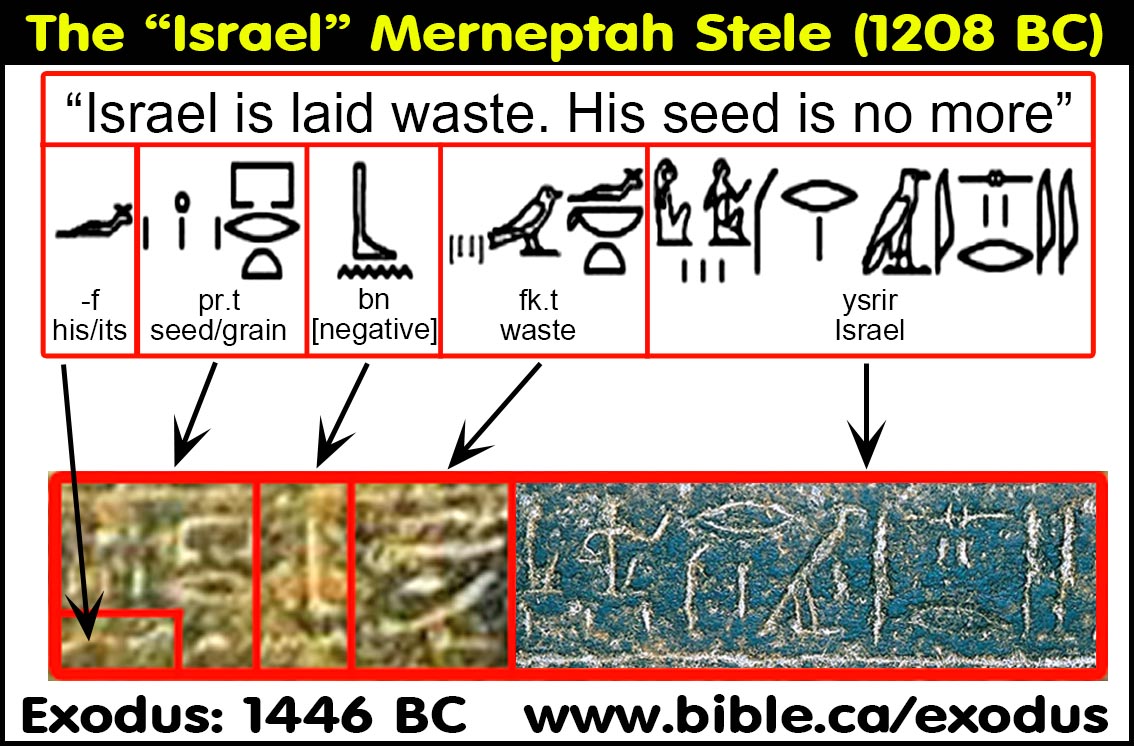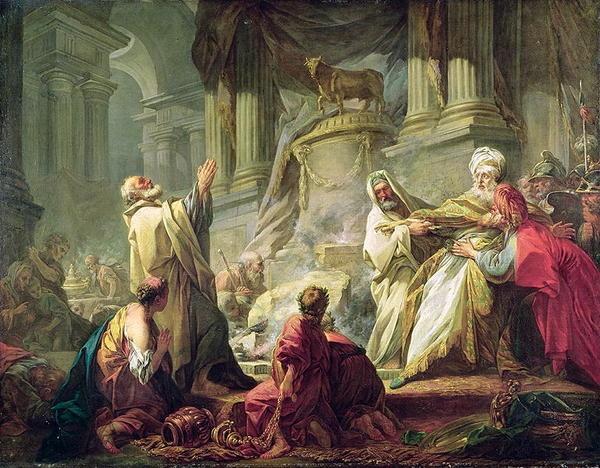by
Damien F. Mackey
“‘I will return the cities my father took from your father’, Ben-Hadad offered.
‘You may set up your own market areas in Damascus, as my father did in Samaria’.”
I Kings 20:34
Ben-Hadad I of Syria has, in this treaty statement of his to the victorious King Ahab of Israel, provided us with some chronological details of the utmost importance towards a revision of the earliest period of the Divided Monarchy.
What the King of Syria is basically saying here to Ahab is that:
Ben-Hadad’s own father, who we know from I Kings 15:18 to have been Tab-rimmon – {“Asa then took all the silver and gold that was left in the treasuries of the Lord’s temple and of his own palace. He entrusted it to his officials and sent them to Ben-Hadad son of Tabrimmon, the son of Hezion, the king of Aram, who was ruling in Damascus”} – had taken cities from Ahab’s father, who we know to have been Omri, the founder of Samaria, and had even set up his market in Omri’s capital city of Samaria.
No doubt the cunning Ben-Hadad I well knew his recent Syro-Israelite history.
His statement, however, must create a massive chronological headache (or so I should think) for the conventional biblico-historians.
Why?
Well Tab-rimmon, as we learn from I Kings 15:19, had not only reigned contemporaneously with Abijah, king of Judah (a contemporary and foe of Jeroboam I (I Kings 15:6)), but had actually signed a treaty with the same Abijah (15:19). No doubt their alliance would go a long way towards accounting for the fact that Abiijah of Judah was able to defeat the mighty Jeroboam of Israel in battle (2 Chronicles 16:13-19), so emphatically, in fact, that (v. 20): “... Jeroboam of Israel never regained his power during Abijah’s lifetime ...”.
Putting all of this together, it must necessitate that Jeroboam and Omri, contemporaneous with Tab-rimmon, were one and the same king. For there is nothing whatsoever to indicate that Israel had two kings ruling at the same time – and this would have been impossible, anyway, given the might of Jeroboam, of Omri.
Admittedly the given reign lengths are substantially different:
I Kings 14:20: “[Jeroboam] reigned for twenty-two years and then rested with his ancestors”.
I Kings 16:23: “In the thirty-first year of Asa king of Judah, Omri became king of Israel, and he reigned twelve years, six of them in Tirzah”.
But geographical factors also need to be taken into account.
Jeroboam appears to have begun at Shechem, but may later have moved to Peniel (or Penuel) (I Kings 12:25), and to Tirzah (14:17).
Tirzah would make perfect sense in my context, because that is from where Omri ruled for six years of his reign. Then Omri built Samaria as his capital (16:24): “[Omri] bought the hill of Samaria from Shemer for two talents of silver and built a city on the hill, calling it Samaria, after Shemer, the name of the former owner of the hill”.
So while the longer reign length attributed to Jeroboam I could pertain to his total reign, the shorter one attributed to Omri would perhaps refer only to his time in Tirzah, and Samaria.
The reign of Tab-rimmon would have coincided with the early reign of Asa, who, I have argued elsewhere, was actually the same person as Abijah (traditionally thought to have been Asa’s father). The Syrian king would not have fought with Asa. The latter’s reign had begun with a decade of peace (2 Chronicles 14:1): “…. In his days the land had rest for ten years”. But that situation would have ensued only after Asa (as Abijah) had smashed Jeroboam I in battle.
Then, after this era of peace, Asa, who had become a foe of Tab-rimmon’s son, Ben-Hadad I, found himself having to form a hasty treaty with the latter in the face of king Baasha of Israel’s belligerence against Judah (I Kings 15:16-18).
Now that we have determined that Omri must have been in serious conflict with the Syrian king, Tab-rimmon, then it becomes quite clear who was the enigmatic Tibni, foe of Omri (16:21-22):
Then the people of Israel were split into two factions; half supported Tibni son of Ginath for king, and the other half supported Omri. But Omri’s followers proved stronger than those of Tibni son of Ginath. So Tibni died and Omri became king.
Tibni could only have been Tab-rimmon, who, for a while, had had the better of the king of Israel.
As I noted above, Ben-Hadad I’s statement to Ahab “must create a massive chronological headache ... for the conventional biblico-historians”.
Or at least it ought to.
And thou shall make streets for thee in Damascus, as my father made in Samaria;
which confirms it that it is Ahab, and not Benhadad, that is speaking; for Benhadad's father never had any power nor residence in Samaria, whereas Omri, the father of Ahab, had, he built it, and made it his royal seat; and, in like manner, Ahab promises Benhadad that he should have his palace at Damascus, the metropolis of Syria, and exercise power there, and over all Syria; whereby Ahab renounced all right he had to the kingdom, and any of the cities of it ....
That is not the way that I read the text.
Nor is it the way that D. D. Luckenbill was reading it back in 1911, when in his article “Benhadad and Hadadezer” (The American Journal of Semitic Languages and Literatures, Vol. 27, No. 3, p. 275), he wrote: “... but because of "Ahab's unseasonable lenity” [Ben-Hadad] was released on condition that he restore the cities his father had taken from Ahab's father (Omri), and that the Israelites be allowed to "make streets," that is, have bazaars in Damascus”.
Vol. 27, No. 3 (Apr., 1911), pp. 267-284 (18 pages)Benhadad and HadadezerD. D. Luckenbill
I have - following T. Ishida - concluded that the House of Jeroboam I – hence of (my) Omri) – was an entity separate from the House of Ahab (my Baasha), even though Ahab is usually designated as a son of Omri. This relationship may thus have been through marriage.
T. Ishida has more to say on such dynastic matters, according to:
Tomoo Ishida instead suggested that the narrative of dynastic instability in the Kingdom of Israel suggests an underlying rivalry between tribes for its throne.[1] In the biblical narrative, the House of Jeroboam was from the Tribe of Ephraim, while the House of Baasha was from the Tribe of Issachar.[1] The Omrides are connected in this narrative with the city of Jezreel, where they maintained a second palace. According to the Book of Joshua, Jezreel was controlled by the Tribe of Issachar. Ishida views the narrative as suggesting that the Omrides themselves were members of the Tribe of Issachar.[1]
The assassinated king Elah and Omri thus shared a "common tribal origin", and were possibly kinsmen. Omri and the Tribe of Issachar's opposition to Zimri indicates that Zimri was not a member of their tribe.[1]
Ishida views both Zimri and his successor Tibni as likely members of the Tribe of Ephraim, its candidates in an attempt to reclaim the throne.[1]
But he also suggests another hypothesis, that Tibni originated from the city of Gina (also known as Beth-haggan) mentioned in the Amarna letters (14th century BC). In the Biblical narrative, this city was under the control of the Tribe of Manasseh. So Tibni could instead be the Tribe of Manasseh's candidate for the throne.[1]
Similarly, genealogist David Hughes speculated that Zimri and Tibni were members of the Tribe of Ephraim, and siblings to each other.[2] He further speculated that they were descendants of Hoshea, son of Azaziah, one of the rulers of the Tribe of Ephraim.[2] Hoshea and Azaziah are characters briefly mentioned in the Books of Chronicles (I Chronicles 27:20), where Hoshea is a contemporary of David:
...of the children of Ephraim, Hoshea the son of Azaziah
Finally, Tibni is referred to as “son of Ginath”, which seems further to complicate my identification. For Tab-rimmon’s father was (as we read in Ben-Hadad I’s statement to Ahab), one “Hezion”.
According to A. Hylton in “Solomon's Satans for criticism”:
Solomon’s foe, Hadad - the Hadar (or Hadad) of Genesis 36:39 - had “allied himself with Rezon of Damascus and established himself in the region of Aram”:
Not many people have been unfortunate enough to be given the title satan. Jobab was given that title by Abraham Abulafia, but unfortunately for Hadad the Edomite and Rezion the son of Eliada they were given the title satan by the Scriptures themselves. In this paper we will reflect on Hadad the Edomite. We think that the author of Kings understood that Hadad the Edomite of 1 Kings 11:14-25 was the same person as Hadar (d) the King who succeeded Baalhanan son of Achbor (David) as king in Edom who in turn succeeded Saul of Rehovoth (Saul) (Gen 36:37-39) and the ancestor to Ben Hadad I (1 Kgs 15:18-20). We will argue that he was a vassal of Pharaoh King of Egypt and that having returned from exile failed to gain enough support in Edom to revolt against Solomon so he moved north to Aram and aligned himself with Rezon of Damascus and established himself in the region of Aram. After he worked with Rezon ruler of Damascus against Solomon he left behind a line of kings called Ben Hadad. Hadad was not his only name we will suggest it was with Hadad Hezion or Hadad Tab-rimmon (1 Kings 15:18-21). ….
My tentative explanation for this would be that “Ginath” was an Egyptian name, given to the son of Hadad, as “Genubath” in Egypt. I tentatively conclude that Ginath was Genubath.
Previously I wrote on this:
As for “Genubath”, the son of Hadad, Velikovsky had rather strikingly identified his name amongst those giving tribute to Thutmose III, very soon after the latter’s First Campaign. Velikovsky wrote about it (in ch. iv) in “Genubath, King of Edom” (pp. 179-180):
Hadad had returned to Edom in the days of Solomon, after the death of Joab [I Kings 11:21-22]. Since then about forty years had elapsed. Genubath, his son, was now the vassal king of Edom …. Tribute from this land, too, must have been sent to the Egyptian crown; there was no need to send an expedition to subdue Edom.
When Thutmose III returned from one of his inspection visits to Palestine he found in Egypt tribute brought by couriers from the land, “Genubatye”, which did not have to be conquered by an expeditionary force.
When his majesty arrived in Egypt the messengers of the Genubatye came bearing their tribute.3 [3. Breasted: Records, Vol. II, Sec. 474].
It consisted of myrrh, “negroes for attendants”, bulls, calves, besides vessels laden with ivory, ebony, and skins of panther.
Who were the people of Genubatye? Hardly a guess has been made with regard to this peculiar name. The people of Genubatye were the people of Genubath, their king, contemporary of Rehoboam. ....



